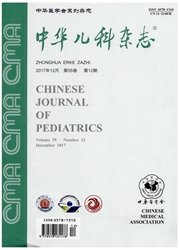

 中文摘要:
中文摘要:
目的观察机械通气新生儿气管导管表面生物膜细菌群落多样性,探讨以变性梯度凝胶电泳(DGGE)技术为基础的细菌鉴定方法与传统培养法的差异,为临床预防、诊疗细菌性感染提供新思路。方法以重庆医科大学附属儿童医院新生儿中心2011年10月至2012年3月经治的26例患儿35根气管导管为研究对象,依靠16SrDNAPCR—DGGE技术,通过quantityone软件分析气管导管表面生物膜中细菌群落多样性,通过T—A克隆测序,了解生物膜中细菌种类分布及常见优势菌。结果35根气管导管经16SrDNAPCR—DGGE所得条带13.8±5.4,香农威纳指数2.42±0.38。16份标本来自7例患儿不同疾病阶段,其中6例患儿气管导管留置天数增加,香农威纳指数减小。6例不同基础疾病患儿的气管导管标本香农威纳指数各不相同。回收24条优势条带克隆测序。35份标本中检出克雷伯菌属100%、假单胞菌属80%、链球菌属77%,91%的标本中存在无法培养的细菌,97%检测到2种以上菌属。80%克雷伯菌属和82%链球菌属中分别与假单胞菌属伴随存在。22例有临床痰培养结果,肺炎克雷伯菌10例(45%),鲍曼不动杆菌2例(9%),阴沟肠杆菌、阴性结果各1例(5%),培养结果均为单菌属。8例痰培养显示“正常菌群”,其对应导管上均检测到克雷伯菌等菌属。结论气管导管表面生物膜中细菌群落具有多样性;16SrDNAPCR—DGGE技术相比培养法更能全面反映气管导管表面细菌群落组成和多样性;克雷伯菌属、假单胞菌属及链球菌属是气管导管表面生物膜中常见菌属,它们在生物膜形成过程中可能存在相互作用。
 英文摘要:
英文摘要:
Objective The catheter-related infections caused by mechanical ventilation have become a intractable clinical problem, and it is related to the formation of bacterial biofilm (BF) on the surface of the implanted material. The majority of natural biofilms are formed by multiple bacterial species. However, there always only one or limited species were detected on tracheal tubes removed from intubated neonates by using traditional methods including bacterium culture and antigen detection. The aims of this study were to observe the bacterial communities diversity of BF on endotracheal tube (ETI'), and discuss the difference between traditional bacterium culture methods and the use of molecular biology techniques on the basis of denatured gradient gel electrophoresis (DGGE), to provide new ideas for clinical prevention, diagnosis and treatment of bacterial infections. Method Thirty-five E'I'Fs were obtained from 26 neonates on mechanical ventilator (from October 2012 to March 2013 ) in Department of Neonatology of Children's Hospital. Among the patients, 18 were boys and 8 girls, and 19 patients were 〈 37 weeks gestational age and 7 patients 937 weeks. DGGE profiling of 16S rDNA gene amplicons was used to assess the diversity of the bacterial population by using the software of quantity one. TA Cloning Kit and sequencing were used to investigate the distribution of bacteria and common dominant bacteria in ETI'-BF. Result The mean bandsof 35 ETrs cases were 13.8 ± 5.4 from 16S rDNA PCR-DGGE, and the mean Shanon-wiener indexes was 2.42 ±0. 38. The 16 ETYs were collected in different stages of diseases from the 7 patients. The indwelling days of 6/7 patients' ETYs increased, the Shanon-wiener indexes were decreased. Among the 6 cases from different basic illnesses, and there were different Shanon-wiener indexes. The result of molecular cloning and sequencing for 24 dominant bands showed that 35 cases (100%) contained KlebsieUa SP., 28 cases (80%) had Pseudomonas SP. , 27 cases (7
 同期刊论文项目
同期刊论文项目
 同项目期刊论文
同项目期刊论文
 期刊信息
期刊信息
